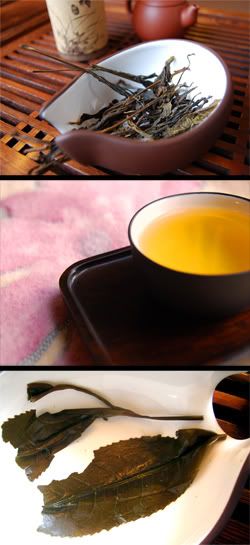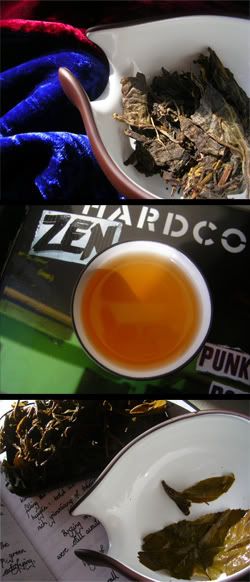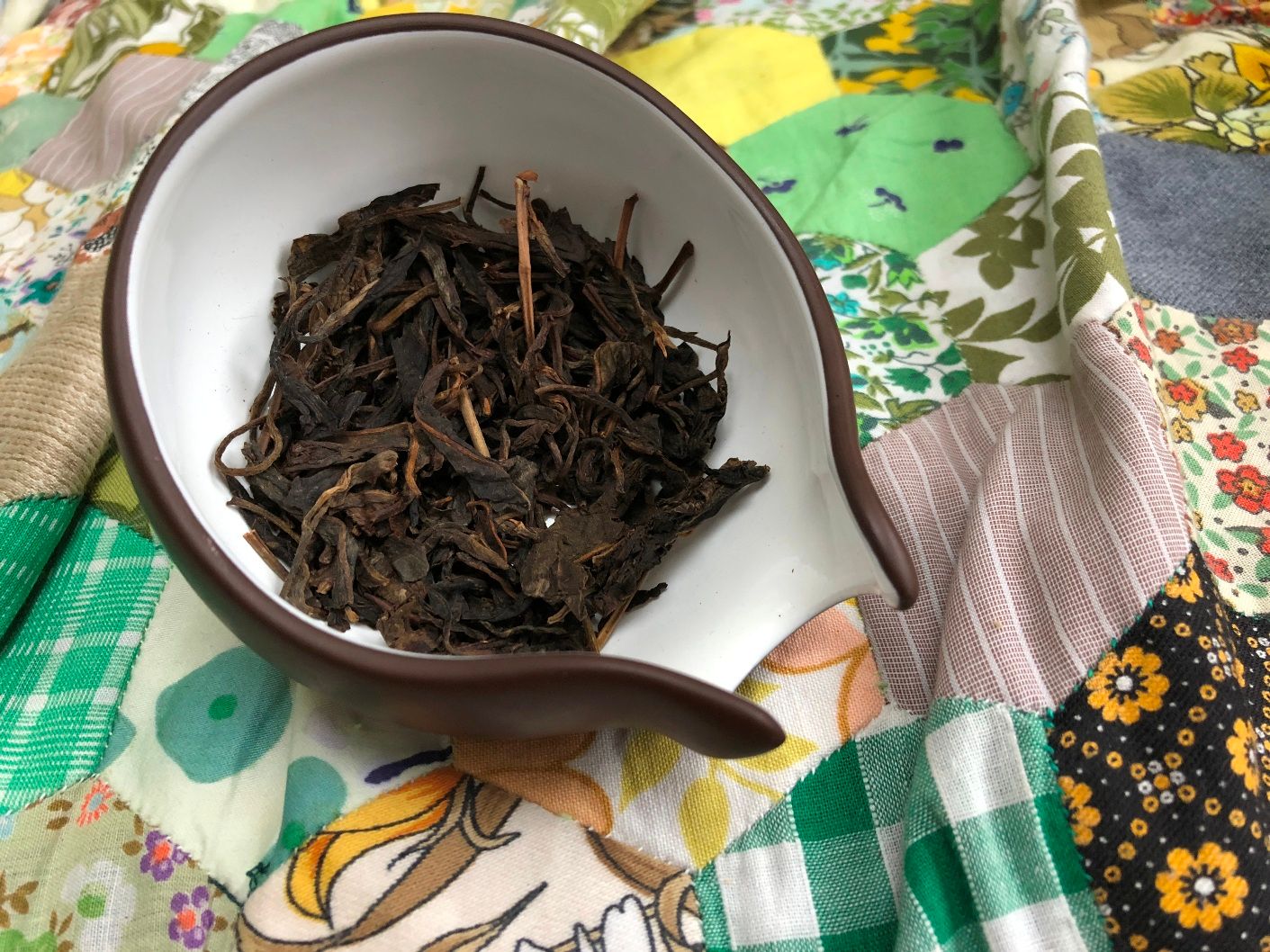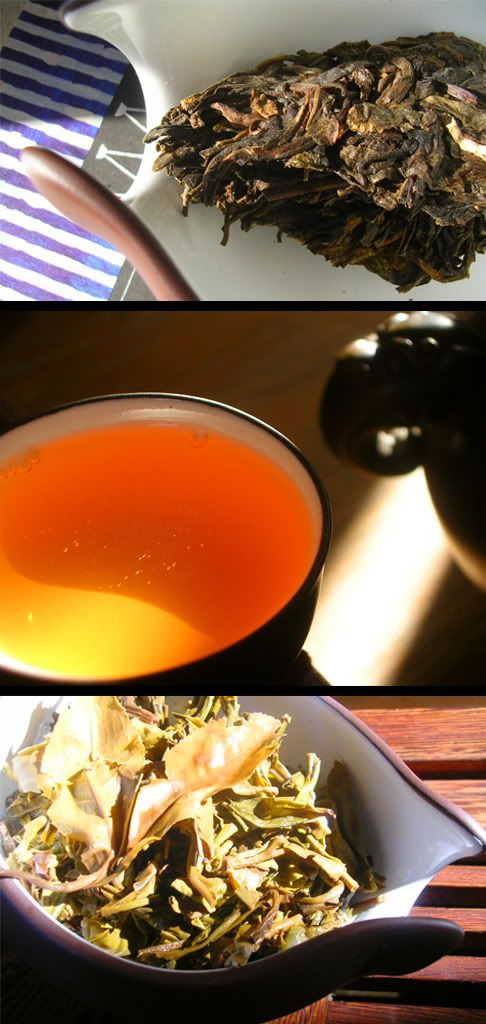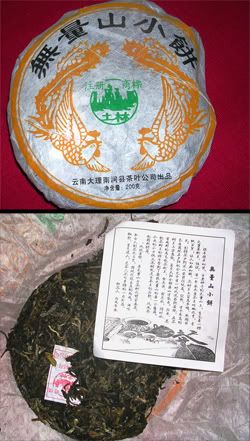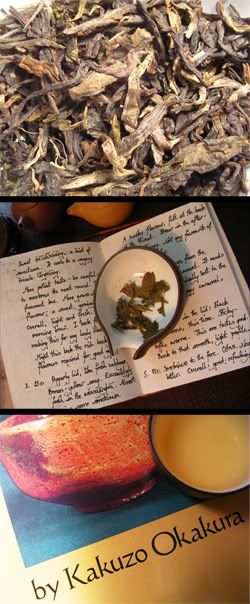I've been on an unusual tea-drinking quest of late, finding myself unusually often in the SCR [Senior Common Room] of various colleges. Despite the surprising quality of the wine, coffee, and cheese that each provides, the tea is woefully sub-par. Or, rather, it's extremely normal (which is much the same). My quest is to find an SCR that serves good tea. There are 39 colleges here - the odds were initially on my side, but now I'm running out of options.

Back at the tea-table, it's time for some proper tea. At last.
This one is from the
imaginatively-named "
Yiwu Zhengshan Tea Company" - what a name. It's a cake from
Xiaomei, the tea vendor in
Maliandao whose shop seemed to be an eternal tea-party (although admittedly consisting of the same guests each day).
Dry leaves
Ahh, tobacco. I recall the last time that I mentioned my preference for such a characteristic, an actual cigarette butt revealed itself in a dodgy block of
shupu - I'll try not to tempt fate.
The leaves of the cake are singular and dark, and have the scent of fine, sweet... tobacco. Excellent.
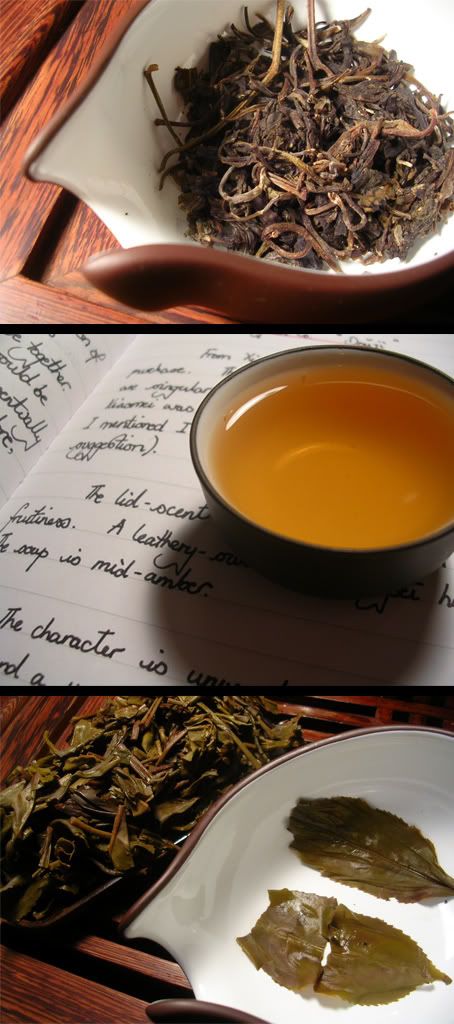
The lid-scent is robust and expectedly green (being under a year old), with a certain fruitiness. The leathery-sweet wenxiangbei hints at more tobacco.
The character of the tea is uniquely tangy: so very tangy, with dark fruits, and a very sweet, fruity nose - it's a cross between tangy shengpu and a dessert wine.
Plenty of ku, tasting very much like "tea", which other cakes seem to often only approach near the end of their sessions. The smooth texture is almost slippery, it's so thick.
Wet leaves
They're big, but they're chopped plentifully. Examining the few larger exemplars reveals a healthiness of leaf and strong stems - no overfarming here, apparently.
Overall
A bit fruity, and the tang really necessitates a good few years to mellow. Overall, it's pleasant, and rather inexpensive (but, then again, it was bought in China, which is a bit of an unrepresentative statement).
Addendum
January, 2011
This tea has "gone quiet". I still enjoy its tobacco-like finish. Fun, but currnetly limited, in its sweet, straw-like way. Perhaps January isn't the best time to revisit a tea.
Addendum
September, 2012
It's a
Hster vs. Hobbes fight to the finish.
Both Hster and I have stored this tea since 2006, in Berkeley, California and Oxford, England, respectively. How do they shape up, when facing one another?
I rememmber digging this tea in far out and happening ways for quite some time. However, it's been a while since I last tried it. As you will see from my notes above, I have only dipped into it once in recent years, to find that it had gone rather quiet. This happens now and again with some cakes; I don't worry if a cake has a sleep - I do worry if it doesn't wake up.
This batch of teacakes is the result of a few purchases, from Maliandao and from Scott of
Yunnan Sourcing. In bought most of them for about US $20, which is a laughable price at today's rates. It is a shame to see that pu'ercha has become so much more expensive - perhaps this makes us more careful, which can only be a good thing.
The cake shown above took some damage in my suitcase on the way back from Beijing one autumn. I remember coming back via Moscow, where the entirety of my tea purchases were searched by a huge Russian woman who could easily have crushed me. Her arms were thicker than my torso.
This cake is beautiful, and I will brook no dissent. Even the photograph gets me thirsty. My version has a strong, plummy scent that fills the room when I slide the wrapper away, suggesting that it sleeps no longer.
The leaves are long and luscious - considering this cake costs a mere twenty of your liberal American bucks, the quality of the leaves is really rather staggering.
The length is such that they actually require pre-softening with warm water, such that they can be put into the teapot without damage. For twenty dollars. It's criminal.
I wrote "My old friend seems very much awake today. The soup is a strong yellow, darkening to orange in the gongdaobei [fairness cup] as I write. The aroma is tangy, sweet, and then a remarkably heavy base of tobacco. It has a strong Yiwu body, shengjin [pleasant mouth-watering], and a vibrantly sweet aftertaste. Underneath that lies the stratum of stick molasses that I originally loved in it."
"There is a very decent sweetness that penetrates the mouth, and which results in a cooling huigan [throaty aftertaste]. The genre is unmistakeably that of Yiwu sweet-straw. It is encouraging to see that the English climate has nurtured this cake so well."
I came back to it a few weeks after trying Hster's cake, and added: "Clean, vivid, orange, sweet, and woody. Vibrant and cooling, I like it very much. Soft, tobacco base and the character os sweet straw. Numbness at the tip of the tongue."
The ladywriting above can only be that of Hster, and it is a great pleasure to be able to try another version of one of my favourites.
Hster's cake looks just as charming as my versions, and I wonder how the dry storage will have affected it in the course of six year. I wrote that "The cake certainly seems brittle, and is subdued in aroma."
"The California version is doing well, but it is very dry - it does not have the 'damp straw' of our version, and has a lighter base, free of tobacco. It is sweet and accomplished, but tastes light and young."
I enjoyed it very much, unsurprisingly. It is fascinating indeed to see how two cakes, separated at birth but raised in different countries, can lead to such different results. I wouldn't like to say that one is better than the other, as both gave me excellent sessions, but they are definitely birds of a different feather. I suspect that, in the end, we become attuned to our own collections, and I am sure that there is a degree of "echo chamber" effect occurring, where I convince myself that our teas are all proceeding marvellously, no matter where we live.
Ultimatley, if it tastes good to you, then you're doing it right. Both Hster's and my cakes fit easily into the category of "good tea", no matter their differences, and so I conclude that we can rest easy.
Addendum
August, 2018
Six years later, and we have action!
This tea is solid. It is also unexpectedly fragrant - the cake itself assaults the senses, and the separated leaves taken downstairs to the teatable do likewise.
This cake was made "black", which seems to be the house style for Douji. To process a cake in such a way is a very brave decision, for who knows, in 2006, how such a cake would turn out? There are almost no data on which to rely, because I find very few cakes processes in this "black" manner from ages before that. This is the character taken to the extreme by the "FT" cakes produced by Xiaguan, among others.
The "black" character is present, 12 years later, but the aggressive raw youth of the cake has rounded, smoothed, and balanced to complement it very well indeed. The sweetness is surprisingly enduring, and, in perhaps one of the most obvious markers of quality, its texture is exceptionally thick. It "coats the tongue" with its soup, such is the thickness, and the effect (combined with the sweetness and black character) is enjoyable.
This is perhaps the first evidence that I have seen of how a cake with "black" processing will grow up, for it is only now that these cakes are coming somewhere approximating age. (As noted before, the English climate is good for preserving a cake's character, thanks to the native humidity, but aging is slow due to the lack of blisteringly-hot temperatures.)
The cake is, clearly, plantation tea. It cost just £13 in 2006 (!!), which is cheap even for those days. The flat, green plantation character is discernible, but it has aged and smoothed along with the rest of the cake; the leaves were strong enough, as noted above, to age well and to retain a thick texture, which is a great outcome for such a "little" (i.e., affordable) cake.
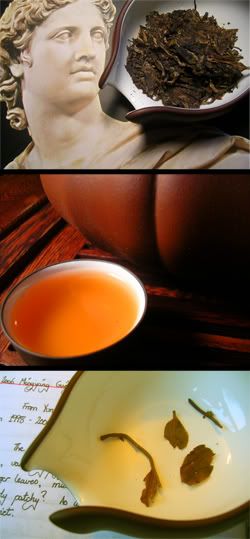 The leaves, as expected for the fairly brusque and eclectic nature of the blend, are varied: a large proportion are tiny leaves, variously fragmented, but there are occasional clumps of larger leaves, mixed with plenty of tips. As with some other blends, the aroma is fairly quiet - as if there's not really enough of any one component to make an impression.
The leaves, as expected for the fairly brusque and eclectic nature of the blend, are varied: a large proportion are tiny leaves, variously fragmented, but there are occasional clumps of larger leaves, mixed with plenty of tips. As with some other blends, the aroma is fairly quiet - as if there's not really enough of any one component to make an impression. The leaves, as expected for the fairly brusque and eclectic nature of the blend, are varied: a large proportion are tiny leaves, variously fragmented, but there are occasional clumps of larger leaves, mixed with plenty of tips. As with some other blends, the aroma is fairly quiet - as if there's not really enough of any one component to make an impression.
The leaves, as expected for the fairly brusque and eclectic nature of the blend, are varied: a large proportion are tiny leaves, variously fragmented, but there are occasional clumps of larger leaves, mixed with plenty of tips. As with some other blends, the aroma is fairly quiet - as if there's not really enough of any one component to make an impression.

